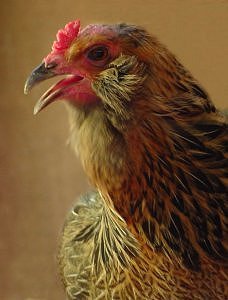
When chickens are hot, they breathe through their mouths.
I started playing with the effects on the photo program.

Hot waxed chicken.

Solarized hot wax chicken.
Early to bed and early to rise , makes a man healthy , wealthy and wise ------ Benjamin Franklin



 Just as I was lamenting the difficulty of finding classic commuter panniers that fit a variety of bikes and racks, a new company appeared offering just that: Philosophy Bags, based in Portland, OR. Handmade in the USA out of locally sourced materials, the description and looks of these bags were almost too good to believe, so I had to see for myself. Philosophy sent me their two pannier models to review: The Intrans satchel (above left), and two versions of the narrow Burnside (above right). We agreed that I would purchase the ones I wanted to keep, if any, and return the ones I did not.
Just as I was lamenting the difficulty of finding classic commuter panniers that fit a variety of bikes and racks, a new company appeared offering just that: Philosophy Bags, based in Portland, OR. Handmade in the USA out of locally sourced materials, the description and looks of these bags were almost too good to believe, so I had to see for myself. Philosophy sent me their two pannier models to review: The Intrans satchel (above left), and two versions of the narrow Burnside (above right). We agreed that I would purchase the ones I wanted to keep, if any, and return the ones I did not. 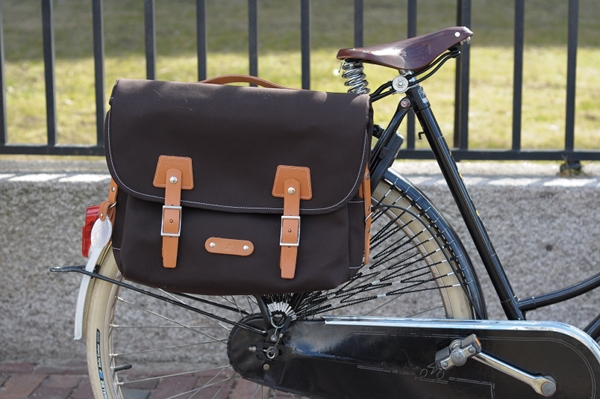 Overview of the Models
Overview of the Models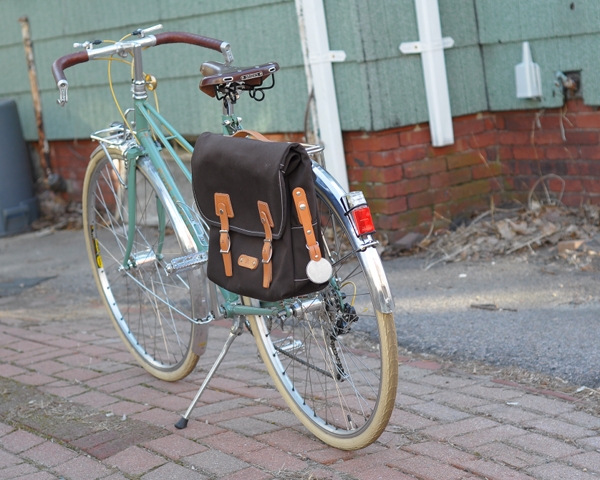 The proportions of the pannier itself are equally suitable for heavy-duty Dutch bikes and for more delicate roadbikes or mixtes. Although large, it does not give the impression of overwhelming a bike, as many other panniers do. And despite its size, heelstrike can be avoided on the majority of bike and rack combinations thanks to the adjustable hooks of the mounting system (details later in the review).
The proportions of the pannier itself are equally suitable for heavy-duty Dutch bikes and for more delicate roadbikes or mixtes. Although large, it does not give the impression of overwhelming a bike, as many other panniers do. And despite its size, heelstrike can be avoided on the majority of bike and rack combinations thanks to the adjustable hooks of the mounting system (details later in the review). To my eye the Intrans looks most "at home" on a large, classic, upright bicycle - but this is a matter of personal taste.
To my eye the Intrans looks most "at home" on a large, classic, upright bicycle - but this is a matter of personal taste.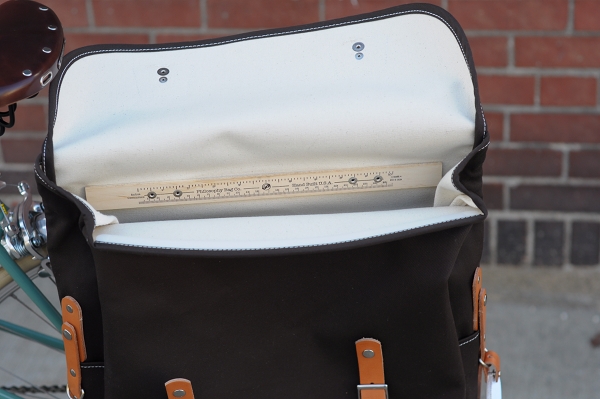 Once opened, the satchel reveals a slight, expandable "roll top" - making it a bit more roomy than it appears to be when closed. The inner fabric is off-white. Inside is a suspended compartment with two medium pockets. A wooden ruler is attached to the base of the outer flap and acts as a support for the leather handle.
Once opened, the satchel reveals a slight, expandable "roll top" - making it a bit more roomy than it appears to be when closed. The inner fabric is off-white. Inside is a suspended compartment with two medium pockets. A wooden ruler is attached to the base of the outer flap and acts as a support for the leather handle. The Philosophy Burnside is a more unusual pannier. Narrower and longer than the Intrans, its outside dimensions are11.5x14x6". The narrower design makes it ideal for bicycles with short chainstays and small racks.
The Philosophy Burnside is a more unusual pannier. Narrower and longer than the Intrans, its outside dimensions are11.5x14x6". The narrower design makes it ideal for bicycles with short chainstays and small racks. Though it does not look out of place on a heavy upright bicycle either. It is not a small pannier, just a differently oriented one. A clever design that is both roomy and avoidant of heelstrike.
Though it does not look out of place on a heavy upright bicycle either. It is not a small pannier, just a differently oriented one. A clever design that is both roomy and avoidant of heelstrike.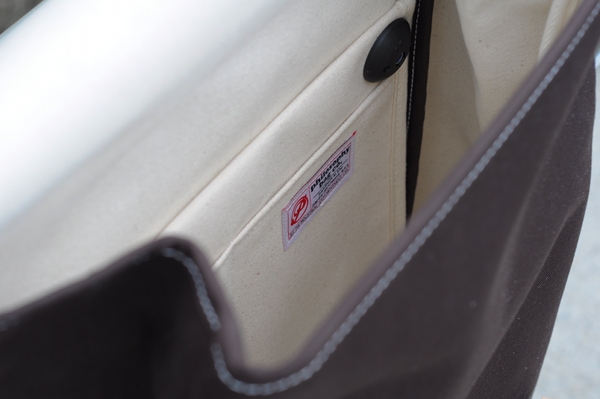 Inside is the same suspended double-pocket as on the Intrans, only narrower.
Inside is the same suspended double-pocket as on the Intrans, only narrower.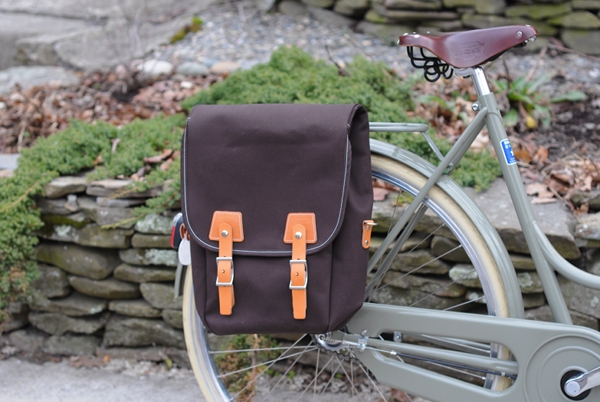 The genius of the Burnside design is its expandability. While on the outside, it looks like a classic pannier, once opened it reveals itself to be a roll-top, offering considerably more room than one would have expected (the expandability feature is more dramatic than on the Intrans).
The genius of the Burnside design is its expandability. While on the outside, it looks like a classic pannier, once opened it reveals itself to be a roll-top, offering considerably more room than one would have expected (the expandability feature is more dramatic than on the Intrans). Here is the Burnside with the buckles open. Because the roll-top expands upwards, there is no possibility of heelstrike when the bag is opened; you can fill it will groceries and keep cycling.
Here is the Burnside with the buckles open. Because the roll-top expands upwards, there is no possibility of heelstrike when the bag is opened; you can fill it will groceries and keep cycling. This is what the Burnside looks like filled with 1.5 bags worth of groceries.
This is what the Burnside looks like filled with 1.5 bags worth of groceries.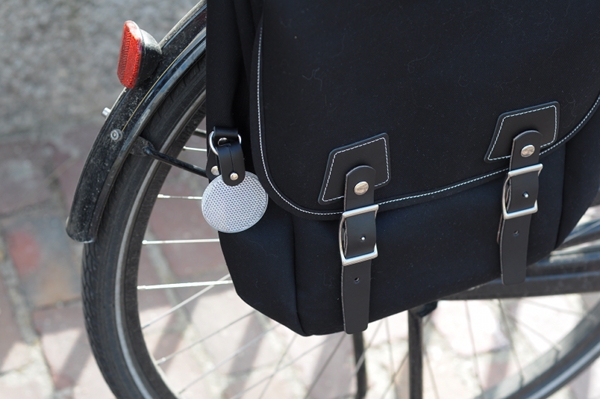 Features
Features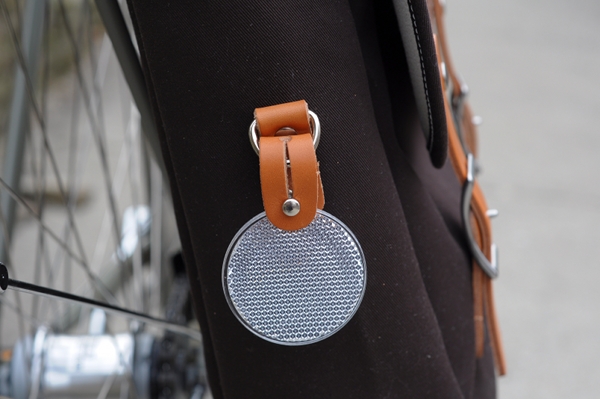 Detachable messenger straps are included with both bags, as are leather teathers for the optional attachment of rear reflectors. The reflector can be moved from one D-ring to another, depending on what side of the bike you attach the pannier to.
Detachable messenger straps are included with both bags, as are leather teathers for the optional attachment of rear reflectors. The reflector can be moved from one D-ring to another, depending on what side of the bike you attach the pannier to. The buckles feature snap-closure attachment, making the bags fast and easy to open and close on the go.
The buckles feature snap-closure attachment, making the bags fast and easy to open and close on the go.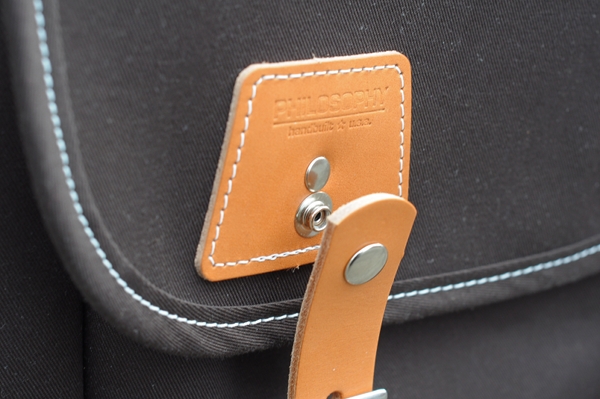 The snaps are heavy duty and secure.
The snaps are heavy duty and secure.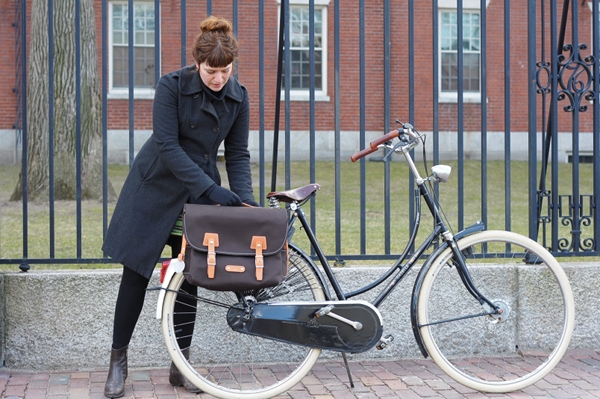 The satchel-like Intrans pannier comes standard with a leather handle, and such a handle can also be added to the Burnside as an optional extra feature.
The satchel-like Intrans pannier comes standard with a leather handle, and such a handle can also be added to the Burnside as an optional extra feature. Mounting System
Mounting System The R&K system isadaptable to racks with a variety of tubing diameters (8-16mm), making it extremely versatile. The hooks are not only large enough for racks with thick tubing, such as my Gazelle, but they are also sprung - which allows them to close just as tightly around racks with thinner tubing, eliminating bouncing.
The R&K system isadaptable to racks with a variety of tubing diameters (8-16mm), making it extremely versatile. The hooks are not only large enough for racks with thick tubing, such as my Gazelle, but they are also sprung - which allows them to close just as tightly around racks with thinner tubing, eliminating bouncing. The hooks are attached to a long aluminum rail, along which they can be slid to a position that avoids heel strike even on bikes with shorter chainstays.
The hooks are attached to a long aluminum rail, along which they can be slid to a position that avoids heel strike even on bikes with shorter chainstays. The lower hook is supplementary, and helps keep the bottom of the bag from bouncing or flapping. The plastic side-hook slides along the rail and clips to the racks stays.
The lower hook is supplementary, and helps keep the bottom of the bag from bouncing or flapping. The plastic side-hook slides along the rail and clips to the racks stays.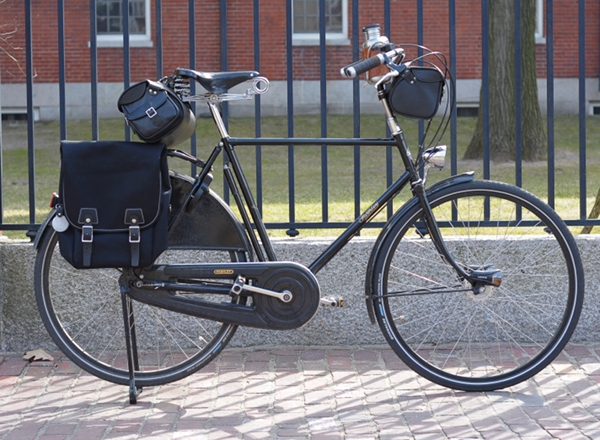 I have tried the R&K Klickfix system on four bicycle racks so far: The Velo Orange Constucteur Rack with thin tubing, the handmade Bella Ciao rack with medium tubing, the Gazelle rack with thick tubing, and the Pashley Roadster rack with monstrous (even thicker than the Gazelle) tubing. On the Pashley Roadster rack,the R&K hooks are a tight fit, possibly too tight for recommended use.On all the other racks, themounting system fits without issues. Regarding the PashleyRoadster rack, note that the largeOrtlieb QL-2 hooks fit equally tightly, and note also that the Pashley Princess does not use the same rack as the Roadster and the R&K system should fit it easily. It's possible that the tubing of this particular bike's rack is simply too thick for any pannier.
I have tried the R&K Klickfix system on four bicycle racks so far: The Velo Orange Constucteur Rack with thin tubing, the handmade Bella Ciao rack with medium tubing, the Gazelle rack with thick tubing, and the Pashley Roadster rack with monstrous (even thicker than the Gazelle) tubing. On the Pashley Roadster rack,the R&K hooks are a tight fit, possibly too tight for recommended use.On all the other racks, themounting system fits without issues. Regarding the PashleyRoadster rack, note that the largeOrtlieb QL-2 hooks fit equally tightly, and note also that the Pashley Princess does not use the same rack as the Roadster and the R&K system should fit it easily. It's possible that the tubing of this particular bike's rack is simply too thick for any pannier. Criticisms
Criticisms Which to Keep?
Which to Keep?




 Smart, easy to talk to and really funny too. Mostly, I noticed how peaceful of a person she seems to be. I had a very comfortable day with her and her very cool kids.
Smart, easy to talk to and really funny too. Mostly, I noticed how peaceful of a person she seems to be. I had a very comfortable day with her and her very cool kids. We met up at Lake Louisa, along with Aric and Ace, and did some hiking. Although Aric says it is not hiking. It is Florida trail walking. I tend to agree after having done some true hiking in other states. We still had fun!
We met up at Lake Louisa, along with Aric and Ace, and did some hiking. Although Aric says it is not hiking. It is Florida trail walking. I tend to agree after having done some true hiking in other states. We still had fun!  It's been a bit since I've hiked with younger children. I remembered today what one of the coolest things about younger kids is. They are so timeless. Meaning they just don't change all that much over the years. You can see a huge cultural influence on teens. Not so much with the younger kids. Especially when they are free range kids. This could have just as easily been me and my siblings as kids. Out just exploring the world without a care in the world.
It's been a bit since I've hiked with younger children. I remembered today what one of the coolest things about younger kids is. They are so timeless. Meaning they just don't change all that much over the years. You can see a huge cultural influence on teens. Not so much with the younger kids. Especially when they are free range kids. This could have just as easily been me and my siblings as kids. Out just exploring the world without a care in the world. Her teen son (not sure if I can share his name here or not?) was fascinating. We spent a lot of time talking. I learned a lot about war games from him. And guns. He was awesome. I can't wait until next winter when I can spend more time with him.
Her teen son (not sure if I can share his name here or not?) was fascinating. We spent a lot of time talking. I learned a lot about war games from him. And guns. He was awesome. I can't wait until next winter when I can spend more time with him.










 An additional lower boot eyelet at the ankle and a third set of upper cuff lace hooks make the Phantom Guide different from the Batura. With the addition of a more substantial and well padded tongue all combine to offer more support in the ankle with no loss in flexibility.
An additional lower boot eyelet at the ankle and a third set of upper cuff lace hooks make the Phantom Guide different from the Batura. With the addition of a more substantial and well padded tongue all combine to offer more support in the ankle with no loss in flexibility.







7!Bmk~%24(KGrHqMOKj0EuuHFc0soBLwffgKh8Q~~_3.jpg)